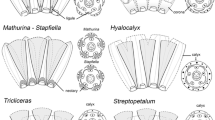Abstract
A study was made on the phylogenetic relationships of species of the family Resedaceae, based on morphological features, chromosome meiotic behaviour, karyotype features, size and fertility of pollen grains, nucleotypic parameters, seed protein profiles and esterase isozyme patterns.
For the comparison of the seed protein profiles among species a method was developed based on the presence or absence of the bands by means of a computer program. The dendrogram obtained by such a method is in line, to a great extent, with the clusters (sections) obtained within the family based on morphological features.
Data on meiotic behaviour and on morphology, such as the type of fruit, carpel numbers and others, suggest that x=5 is the primitive basic chromosome number of this family. x1=6 and x2=7 are considered as secondary basic numbers derived from x=5 through aneuploid changes.
The results support a proposed phylogenetic tree of the genera and sections of the genus Reseda represented in the European Flora.
The principal phenomena that have operated in the evolution of the Resedaceae seem to be aneuploid changes, polyploidy and structural rearrangements. A trend towards DNA increase in the evolution of this group is also apparent.
Similar content being viewed by others
References
Barlow, P. W. & Nevin, D., 1976. Quantitative karyology of some species of Luzula. Plant Syst. Evol. 125: 77–86.
Davies, R. G., 1971. Computer programming in quantitative biology. Academic Press, London and New York.
Eigsti, O. J., 1936. Cytological studies in the Resedaceae. Bot. Gaz. 98(2): 363–369.
Fernández-Peralta, A. M. & Gonzálex-Aguilera, J. J., 1982. Cytogenetic and evolutionary studies on the Spanish species of Reseda L. sect. Luteola Dumort (Resedaceae). Taxon 31(1): 1–8.
González-Aguilera, J. J. & Fernández-Peralta, A. M., 1981. Karyology and evolution in Sesamoides. Plant. Syst. Evol. 139: 147–154.
González-Aguilera, J. J. & Fernández-Peralta, A. M., 1983. The nature of polyploidy in Reseda sect. Leucoreseda (Resedaceae). Plant. Syst. Evol. 142: 223–237.
González-Aguilera, J. J., Fernández-Peralta, A. M. & Sañudo, A., 1980a. Estudlos citogenéticos y evolutivos en especies españolas de la Familia Resedaceae L. Sección Glaucoresda D. C. An. Jard. bot. Madr. 36: 311–320.
González-Aguilera, J. J., Fernández-Peralta, A. M. & Sañudo, A., 1980b. Cytogenetic and evolutionary studies on the Spanish species of the Family Resedaceae L.: Sections Phyteuma L. and Resedastrum Duby. Bol. Soc. Brot. Ser. 2, 23: 519–536.
Gori, C., 1957. Embriologia e citologia di alcune specie del gen. Reseda. Caryologia 10: 391–401.
Grant, W. F., 1969. Decrease DNA content of birch (Betula) chromosomes at high ploidy as determined by cytophotometry. Chromosoma 26: 326–336.
Kearcher, W. & Valdés-Bermejo, E., 1975. Contribución al estudio cariológico del Género Reseda L. en España. Nota I. Sección Leucoreseda. An. Inst. bot. A. J. Cavanilles 32(2): 165–174.
Oksijuk, P., 1929. Akad. Sci. l'Ukraine, Mem. Classe Sci. Phys. et Math. Trav. Mus. Bot. 15: 37–50 (after Eigsti, 1936).
Oksljuk, P., 1935. Akad. Sci. l'Ukraine. J. Inst. Bot. 12: 15–18 (after Eigsti, 1936).
Probst, F., 1972. Contribution à l'étude taxonomique du genre Leucanthemum par voie cytophotométrique. Chromosoma 36: 322–328.
Rees, H., 1972. DNA in higher plants. pp. 394–417. In: Evolution of genetic systems. H. H. Smith (ed.). Gordon and Breach Science Publishers Ltd.
Seal, A. G., 1983. DNA variation in Festuea. Heredity 50(3): 225–236.
Sparrow, A. H. & Nauman, A. F., 1973. Evolutionary changes in genome and chromosome sizes and in DNA content in the grasses. Brookhaven Symp. Biol. 25: 367–389.
Stebbins, G. L., 1974. Flowering plants. Belknap Press, Harvard University Press. Cambridge, Massachusetts.
Taper, L. J. & Grant, W. F., 1973. The relationships between chromosome size and DNA contenf in birch (Betula) species. Caryologia 26: 263–273.
Valdés-Bermejo, E. & Castroviejo, S., 1977. Notas cariosistemáticas sobre la Flora Española II. An. Inst. bot. A. J. Cavanilles 34(1): 325–334.
Vaughan, J. G. & Denford, K. E., 1968. An acrylamide gel electrophoretic study of the seed proteins of Brassica and Sinapsis species with special reference to their taxonomic value. J. exp. Bot. 19: 724–732.
Verma, S. C. & Rees, H., 1974. Nuclear DNA and the evolution of allotetraploid Brassicae. Heredity 33(1): 61–68.
Author information
Authors and Affiliations
Rights and permissions
About this article
Cite this article
González-Aguilera, J.J., Fernández-Peralta, A.M. Phylogenetic relationships in the family Resedaceae L.. Genetica 64, 185–197 (1984). https://doi.org/10.1007/BF00115343
Received:
Accepted:
Issue Date:
DOI: https://doi.org/10.1007/BF00115343




